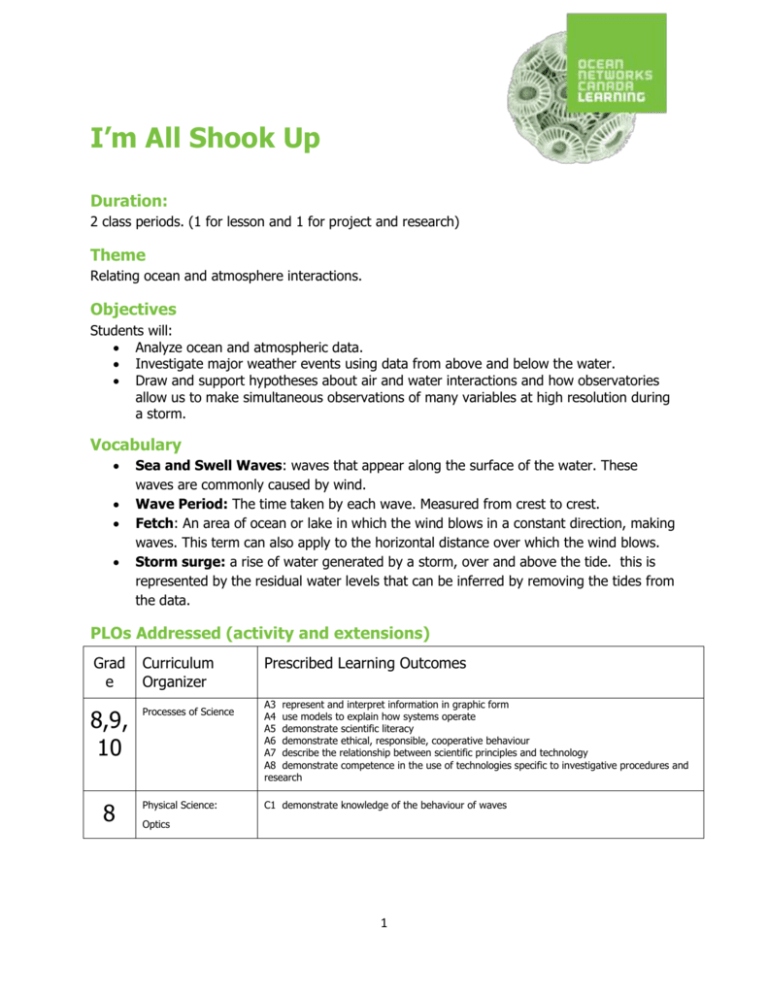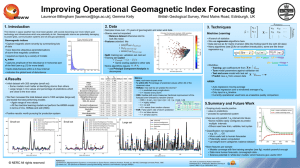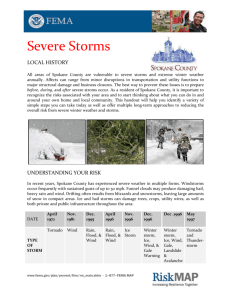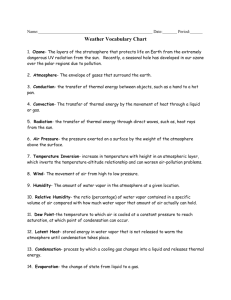Lesson_Plan_Observatories
advertisement

I’m All Shook Up Duration: 2 class periods. (1 for lesson and 1 for project and research) Theme Relating ocean and atmosphere interactions. Objectives Students will: Analyze ocean and atmospheric data. Investigate major weather events using data from above and below the water. Draw and support hypotheses about air and water interactions and how observatories allow us to make simultaneous observations of many variables at high resolution during a storm. Vocabulary Sea and Swell Waves: waves that appear along the surface of the water. These waves are commonly caused by wind. Wave Period: The time taken by each wave. Measured from crest to crest. Fetch: An area of ocean or lake in which the wind blows in a constant direction, making waves. This term can also apply to the horizontal distance over which the wind blows. Storm surge: a rise of water generated by a storm, over and above the tide. this is represented by the residual water levels that can be inferred by removing the tides from the data. PLOs Addressed (activity and extensions) Grad e 8,9, 10 8 Curriculum Organizer Processes of Science Physical Science: Prescribed Learning Outcomes A3 represent and interpret information in graphic form A4 use models to explain how systems operate A5 demonstrate scientific literacy A6 demonstrate ethical, responsible, cooperative behaviour A7 describe the relationship between scientific principles and technology A8 demonstrate competence in the use of technologies specific to investigative procedures and research C1 demonstrate knowledge of the behaviour of waves Optics 1 8 Earth and Space Science: Water Systems on Earth 10 Life Science: Sustainability of Ecosystems 10 Earth and Space Science: Energy Transfer in Natural Systems D2 describe how water and ice shape the landscape D3 describe factors that affect productivity and species distribution in aquatic environments B1 explain the interaction of abiotic and biotic factors within an ecosystem B3 explain various ways in which natural populations are altered or kept in equilibrium D1 explain the characteristics and sources of thermal energy D2 explain the effects of thermal energy within the atmosphere D3 evaluate possible causes of climate change and its impact on natural systems Background In the simplest sense, cabled ocean observatories allow humans to explore and better understand the ocean through continuous high frequency (resolution) observations. Frequent observations are referred to as ‘high resolution’ because they provide many measurements in a short time, For instance CTD data measured at 1-second intervals is very high resolution compared to CTD data measured at 60-seconds intervals. The former spits out a lot more data than the latter, so the researcher has a better resolution to work with. A good analogy would be a photo image. When viewed in low resolution, it might be hard to make out fine details, but with higher resolution, more can be deciphered from the image. In the conventional way of measurements, where scientists go on ships or deploy battery operated autonomous units, the space available for data storage is very low, so recording high resolution data for a long period is impossible. Due to the cabled observatory technology, the data is not limited by storage space and as a result we are able to record data at very high resolution. This allows scientists to study various phenomena that occur at very high resolution and may not be visible in low resolution data. Furthermore, they allow us to make long-term observations of the ocean as a whole, bringing together the biological, chemical, physical, and geological processes in the ocean. This allows us to identify and explore the connections among processes and events that may not have been observed or noticed before with sporadic data collected in just one point in time. Observatories use a plethora of instruments, including cameras, sensors, robots, and autonomous vehicles to collect a variety of data types, such as vector (i.e. directional data) and scalar data, images, and sounds (acoustics). Ocean Observatories allow researchers to conveniently access and analyze data via the internet, rather than collecting data by themselves, as the instruments connected to an ocean observatory can collect data in remote or difficult to access locations for individual researchers. Observatories also assist in science collaboration, allowing researchers from similar or different fields to easily access analyze and compare data to understand larger ocean processes. For example, the ocean and atmosphere are two very different, but related systems. Observatories allow atmospheric researchers and oceanographers to look at a collection of variables from these distinctly different environments to explore their interactions and better 2 understand how the weather we experience can greatly impact the marine ecosystem and vice versa. The ocean and the atmosphere are intricately interconnected. Moisture and heat absorbed over tropical latitudes may fall as rain far inland, or cool, dry air from the Arctic Ocean may keep winter temperatures cool in the interior. But as much as the ocean influences the weather, the weather also influences the ocean. Wind (both speed and direction of the wind), rain, snow and freezing temperatures can all have a significant and measureable impact on the ocean. The ocean is a major influence on the weather because of all that water (approximately 70% of the earth’s surface is water). Water has a high heat capacity and resists sudden changes in temperature. We can experience this right in our own kitchens. For example, when you boil water to make tea it takes a large amount of energy to heat up the water to a boil; then, once heated, it takes just as long or longer to cool back down to room temperature. The ocean has a similar property on a larger scale, and this impacts much of our global weather. Try this real life experiment when you can: Jump into a lake around noon when the sun is at its peak and the atmosphere is very warm and notice that the water is still cooler than the surrounding atmosphere, on the other hand if you jump into a lake in the evening after sun set you feel the water still warmer than the surrounding environment. This happens for the same reason that water takes longer time to heat and cool (once heated) than the atmosphere due to its high heat capacity. As the sun heats the ocean, it absorbs and stores this heat energy. As the atmosphere cools (at nighttime on the small scale and seasonally on the large scale) the ocean releases this heat energy back into the atmosphere, warming the atmosphere, and thus giving coastal areas milder weather. We can observe this phenomenon in the regional differences seen across Canada during winter. For example, winter in Vancouver is going to be a lot warmer than winter in Regina. Equally, Saskatchewan is likely to experience high temperatures in the summer, and cold temperatures in the winter as the land and air are unable to retain or store energy from the sun. Further, because there are no large water masses surrounding this area to hold any heat, the weather is likely to be colder in the winter and warmer in the summer. This difference occurs because land and air are poor at absorbing and storing heat energy, which is why we tend to see greater seasonal atmospheric changes in landlocked places. Coastal areas, such as the coast of British Columbia, experience a much smaller seasonal change between winter and summer because they are so close to water. In the summer, the water absorbs much of the energy from the sun, keeping the air cooler. In the winter, it releases much of this heat energy, making the air warmer. Over the course of the year, this makes the temperatures fairly consistent and less likely to go from one extreme to another. But the ocean does not affect the weather alone. The weather can also affect the ocean. For example, high winds cause mixing, allowing oxygen to mix into the upper layers of the ocean. Also high winds can generate sea waves and continue to feed energy to the sea waves until they become saturated with energy and reach the fully developed state called Swell waves. 3 Furthermore, animals and plants can be impacted by the kinetic movement of the waves as they are agitated by high winds. Salinity can also be affected as rain falls and mixes into the ocean and due to increase river discharge into the ocean due to rain induced river floods. Changes in air pressure and wind can also create storm surges that can raise tidelines and effect shores. With increasing sea levels, storm surges can be increasingly destructive to coastal communities. All of these variables need to be investigated independently, but once collected they can be used to look at the overall impact of the event. Activity 1: Materials: Demo: Large tank Freshwater, room temperature Salt solution*, room temperature *make salt solution by dissolving about 75g of salt in 1L of water. Kosher or pickling salt will make a clear solution; table salt will make a milky white solution. 2 colours of food colouring Pipettes *Paper cup with a straw inserted in the bottom OR a narrow funnel and plastic tubing *See note Hair dryer Plastic divider or wide flat spatula Preparation 1. Place the tank in an area where the students can see it, but it won’t be disturbed. 2. Fill the tank ½ to ¾ full with the room temperature water 3. Poke the straw into the Styrofoam cup to make a funnel with a small opening. When you pour the water in the cup, it should slowly come out of the straw. You may need to seal around the straw to prevent leaks. The cup and straw assembly will allow you to direct the flow of salty water under the fresh water. Alternatively, you can use a funnel and narrow tubing to achieve the same results. *NOTE It can be really difficult to pour 2 different water densities into the same container without mixing them. The cup and straw will allow you to focus the denser solution to the bottom of the tank, while allowing the solution to enter the water slowly enough to prevent a lot of mixing. Hold the cup and straw assembly so that it is as near to the bottom of the tank as possible, and slowly pour in the salt solution. The salt solution will flow ‘under’ the fresh water and push it up towards the surface of the tank. Add enough solution to make a band of dense water at the bottom. Classroom Demo: 1. Have the students brainstorm about coastal storms. Are they important to the ecosystem, or purely destructive? How might they impact marine and coastal life? How 4 might coastal life be adapted to seasonal storms? Will the impact of a storm be felt throughout the water column or just at the surface? How would you collect data on the storm? What variables would you need to collect? Storms can be important events in a coastal ecosystem. Storms can refresh oxygen, move sediments and stir the water column. Animals may be adapted for storms by having protective dens, migrating to other areas, or by being soft and flexible. Depending on water depth, storms can be felt throughout the water column. Some helpful variables would be wind speed, light penetration, wave height, and water temperature 2. After some discussion, show the students the tank and explain that it contains two different densities of water. The bottom has a high density, and the top as a low density. Using the pipette, add some food colouring to the dense water. Be sure to add it below the layer that separates the top and bottom. Explain to the students that this represents oxygen and nutrients in the water. 3. Next, use the pipette to add some of the second colour food colouring to the top layer. Tell the students you will be adding a breeze. This is a normal, surface breeze we might experience in the summer. Have the students predict what will happen. 4. Hold the hair dryer almost parallel to the surface blow gently across the surface of the water horizontally. The top layer should begin mixing and moving, while the deeper, denser layer remains motionless. 5. Ask the students to explain what they see. Next, ask them, seeing as small breezes are not able to mix the water very well, how do nutrients get into deeper layers? You may want to readdress the question: are storms beneficial to the ocean? 6. Use the plastic divider or wide spatula to start pushing the water in the container in larger waves. The mixing action should move both layers, even if mixing is only minimal. Explain to the students that your actions represent the larger, more powerful winds we get during storms. This seasonal disturbance helps nutrients and oxygen get into deeper layers (though it is not exclusively responsible for this process). 7. Brainstorm with students, want kind of evidence would you look for to see the effects of storms in the ocean? Evidence may include large waves, a record of a disturbance in the data (for example, a variable may change slightly before returning to normal). Further evidence may include video evidence, both above and below the waves, if available. Discussion Explain how storms can benefit the coastal ecosystem. o Storms cause mixing. This allows for the movement of nutrients throughout the water column. They can also act as a “refresh” for areas that have become depleted of oxygen by mixing in oxygen from the atmosphere. Explain the role of density in the ocean. o Differences in density causes ocean water to stratify, or form layers. This stratification prevents the water from becoming uniform, which allows for the movement of different currents and water bodies. Differing densities of water help keep the deepest layers of the ocean moving. Brainstorm how marine organisms may cope with coastal weather. 5 o Answers may vary depending on location. Some suggestions include: hard shells, soft, flexible bodies, seasonal migrations. Explain the interactions between the ocean and atmosphere during coastal storms. o Coastal storms allow for deeper mixing action of the different ocean layers. They also change the shape of the shoreline through erosion and wave action. Activity 2: Mini Observatory – All Grades. 1. Explain to the students they are going to be looking at data collected during some storms in 2012/2013. In looking at the different pieces of data, they should keep a number of questions in mind, which are listed below: answers have been suggested ‘in general’. Each storm even will be different depending on direction, magnitude and speed of wind and wind and wave induced currents. You may see the trends/ ideas discussed below, but you may also see different trends or events as well. Each data package includes some or all of the following information, depending on availability Wave pressure Water temperature Chlorophyll Salinity Oxygen Light penetration. Data groupings Calm events April 16-28 Storm Events March 19-24 June 16-23 June 7-11 September 28 – October 4 October 8-29 6 Questions to consider: 1. How have the data changed from the periods considered “calm” to periods considered “stormy”? Variables may appear to change suddenly, or they may appear to change from the expected trend. Spikes or valleys may appear or the trend may disappear for the duration of the storm. Further, you may see similar changes in other variables at the same time. 2. How does using multiple variables contribute to our understanding of the event? Multiple variables will allow you to corroborate the event, as a storm will impact many things at once. (If only one variable changes, a storm is unlikely to be the cause). Also encourage students to study the response time lag between variables. 3. Why doesn’t the data change at exactly the same moment? Why might storm “lag” be important to understand the effect on the ecosystem? Storms may travel in different directions, which cause them to affect different sensors at different times. For example, a wave sensor may be north of a CTD. The CTD will notice changes of a north moving storm sooner than a wave sensor will. Storm lag may help animals and plants anticipate changes in their environment (for example, time to hide, time to adjust to changes in salinity.). Also the response time of each sensor may be different. Some sensors are very sensitive to change while the others take a while to respond. 4. Do storms appear to have a “signature?” Or does each storm look different? What data leads you to think it’s a storm (other than the title)? Storms will be unlikely to have a true signature, though some variables may show a general pattern though it is more likely they will all look somewhat different. Off trend changes in different variables, unusual spikes or valleys in the data may all lead to the conclusion that a storm may have taken place. 5. Does the data allow us to determine the direction of the storm? What other data could be added to create a more holistic understanding? Some data could allow us to determine the storms direction, especially if the sensors react to changes in sequence related to their placement on the sea floor. Other data that could contribute to our understanding could include satellite data, environment Canada meteorological data and experiential data (experiencing a storm first hand and then looking at the data). In addition complex analysis on the wave driven currents and directional wave data can provide information on the dominant propagation direction of the storm wave energy and the storm direction 2. Display the data from March 19–24, 2013. These data are from a moderate storm event. Display the data from April 16–28, 2013. These data are from a period considered calm. Look at both data packages and consider the questions above. What other observations do you notice about the data? What questions could be better clarified with more data? Record any questions the data inspire as well as your hypothesis about where the answer might be. 3. Analyze the data and try and determine the *height of the storm (usually the most disruptive period in the data). Use this time frame to look at video data from SeaTube Pro. Compare this to a similar time of day during calm come periods. Do you notice any differences between the calm and storm periods? *Note: the height of the storm may occur over several hours or days, so you can select any video in this time frame. To access SeaTube Pro: 1. Log into the Ocean Networks Canada SeaTube Pro using the Username and Password provided to you. 7 2. If your page does not immediately display the NEPTUNE Canada log in the upper left, from the green menu bar at the top, select a NEPTUNE by clicking on “Tools”, selecting “Network Preference: […]”, and choosing “Switch to NEPTUNE”. 3. Under Location click the “+” next to “Folger Passage”. Click on the “+” to Folger Pinnacle. Click the “+” next to 2013, Use the table above to select a date and time you wish to view. Click on the month you wish to view, and then select the day. Finally, select approximate time period you wish to view. Compare a calm period with a storm period, or the beginning of the storm with the end. Do all the storms have the same impact on the camera? Look at the data from June 7–11, 2013. These data are from a period considered to be stormy. Display the data from June 16–23, 2013 These data are from a period considered to be calm. Look at the data and consider the questions above. Record any questions the data inspire as well as any hypothesis about the answer to your questions. Look at the data from September 28 to October 4, 2013. These data are from a period considered stormy. Compare these data to October 8–29, 2013. This is from a period considered calm. What questions do these data inspire? What conclusion can we draw from the data? Extensions Grade 8 How does the behaviour of the waves impact the different layers of the ocean? o Large, irregular waves allow for different mixing, and for different affects through the water column. How does water shape the landscape of the coast (with and without storms)? o Coastal erosion can be accelerated during storms. How might storms affect species distribution in the environment? o Animals may move (or refuse to settle) in areas largely impacted by storm. Equally, a population may be destroyed or drastically altered by a storm event. How might water density (and nutrient distribution) affect species distribution in the environment? o Different species are adapted to various levels of nutrients and density conditions. If these layers become disturbed, it may affect the species distributed in them. Grade 10 How does an abiotic factor, such as wind, impact a biotic factor in the ocean? o Wind can drive currents that distribute the valuable food and nutrients needed by animals and plants. This can be a leading factor in biotic distribution, as animals will likely congregate in areas where it is easiest to find food. Wind may also play a role in making an area inhabitable for some species. For example, 8 soft bodied animals and plants may not be able to survive in areas that are continually buffeted by wind or wind-driven waves. How might storms keep different populations in equilibrium? o See above. How might changes in storms frequency and intensity (a possible result of climate change) impacts ocean systems?” o More storms could change the shape of the coast via erosion and accretion processes that occur along the coastline, resulting in a change in species distribution. Storms and its direction of propagation are important for mixing nutrients, if storms were to decrease, this may result in less mixing, making it harder for species to survive in this area. An increase in storms can also result in more, and prolonged, precipitation, leading to decreases in the salinity of shallower coastal waters due to increase fresh water inflow from rivers. Increased storm frequency and intensity can increase turbidity in coastal waters, which can cause mixing of particles and an increase in sediment influx that can limit , sunlight and reduce phytoplankton productivity. Lower phytoplankton Productivity means less food availability, which in turn can impact the food web in that area. Local Observatory follow up Storms are not isolated phenomena. In this activity, we have presented data from longstanding observatories, as they allow for multiple examples and instruments. In the coming year, your station will likely experience a storm or strong weather event. We strongly encourage you to connect to the observatory data online and investigate, collect and compare this data. You may be the first to identify a unique storm event response that could be the first of its kind, and may contribute unique knowledge to our understanding of storms in ways that are not yet understood. Equally, storms that may affect one region may have an undiscovered connection and effect on another. For example, the scenarios above were all collected from the western side of Vancouver island, and the Mill Bay observatory is on the east side of Vancouver Island. Depending on the direction of travel, a storm may impact this area in ways not previously understood. 9







